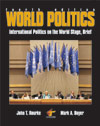Aliens fascinate us. Not the aliens that immigration officials worry about, but the ones that come from other planets. Whether it is the comical others in 3rd Rock From the Sun or the aggressive aliens in the sci-fi thriller Independence Day, our entertainment media are filled with "others." These others can do more than amuse or scare us; they can tell us something. For instance, take the collection of pod racers in Star Wars: Episode 1. They looked and acted rather odd (and nasty, at least to Anakin Skywalker), but in their own home worlds, they probably were very normal. Even though we viewed them as unusual, it is quite possible that they viewed the humanoids around them as odd, ugly, and peculiar in behavior. And maybe the humanoids of all races and colors looked pretty much the same to the various pod racers, who might have found it difficult to tell humanoids apart, even though we human beings often focus more on our differences than on the similarities that exist throughout our human society. The point of this analogy is to get us thinking about our world, how different from and how similar to one another we humans are, and how we categorize ourselves. What we will see is that we do not have an image of ourselves as humans. Rather, we divide up ethnically into Chinese, Irish, Poles, and a host of other "we-groups." Despite our manifest human similiarities, we usually identify and organize ourselves politically around some "we-group" subdivision of humanity. If you think about it, you see yourself politically as a citizen of the United States, or some other country. You might even be willing to fight and die for your country. Would you do the same for your hometown? Or Earth? Nationalism is the country-level focus that makes most people feel patriotic about their country, but not their hometown or their planet. This identification is our traditional political orientation. It has helped configure world politics for several centuries and will continue to shape people’s minds and affairs in the foreseeable future. Few would argue with the observation that "nationalism has been...the nineteenth and twentieth centuries' most powerful political idea" (Taras & Ganguly, 1998:xi). Despite its strength, however, nationalism today is not as unchallenged as it once was. Some even doubt whether it will or should continue and predict or advocate various transnational alternative orientations. This juxtaposition of the traditional nationalist orientation and the alternative transnational orientation represents one of this book's main themes: that the world is at or is approaching a critical juncture where two roads diverge in the political wood. The two paths to the political future--traditional and alternative--were mapped out briefly in Chapter 1. This chapter and those that follow will explore the two roads, usually by comparing them in successive chapters. This chapter, for example, takes up nationalism, the traditional way we identify ourselves politically. Then, in chapter 5, we will turn to alternative, transnationalist orientations. |



 2002 McGraw-Hill Higher Education
2002 McGraw-Hill Higher Education